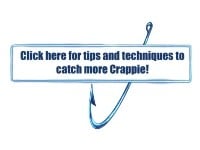Wouldn't you like to stack the deck in your favor when you are out crappie fishing? I mean it's hard enough just to find crappie and get them to bite. Why not arrange things so you have the advantage of crappie by just pulling more lures in front of them.
The technique pulling was shown to me by professional crappie angler and crappie fishing guide Brad Whitehead. His theory was to put out multiple crankbaits and jigs to inundate a wide area and different depths in the water column. To do that, Whitehead had rigged his 1860 model customized War Eagle duck boat with rod holders able to cradle and hold eight rods easily when moving the boat forward with the trolling motor.
Whitehead (Email: bradwhiteheadfishing.aol.com) set up his boat with rod holders able to cradle three rods in the boat's port and starboard aft, in addition to having a rod holder to cradle a single rod off the port bow and starboard bow. "Putting the majority of the rods in the back makes it easy for clients to see the bites and reel in the fish when guiding," said Whitehead.
Most of the time, Whitehead uses Bandit 300 Series crankbaits, but may switch to Bandit 200 Series crankbaits when in shallow water for the back six rods. The front two rods, Whitehead will rig two 32-ounce lead jig head with a Southern Pro soft plastic pink head with black and chartreuse body. The two jigs are about 10-inches apart above a heavy 2-ounce homemade bell sinker.
As for what color of crankbait to use, Whitehead lets the crappie tell him what they want. "I start with six different colors depending on past experience on the body of water I'm fishing than change to what they are biting on that day," said Whitehead. No matter what color of crankbait he ties on, Whitehead will always use a size SZ7 Eagle Claw swivel to reduce line twist and allow him to change colors of crankbaits quickly.
For rods, Whitehead uses B'n'M Poles (www. Bnmpoles.com) 10 foot Pro Staff Trolling rods. "For pulling 1.5- to 1.8-mph you don't want to be using a light action rod. You need a trolling rod with enough backbone to get the crappie in, but still has a light enough tip so it doesn't pull the crankbait out of the soft mouth crappie have," said Whitehead.
Peak time for pulling to catch crappie is from post spawn to sometime in September. The ideal water temperature will be above 75 degrees. "Sunny days are also more productive than cloudy days. I don't know if it's because crankbaits have a shadow on sunny days or it stages the crappie different, but pulling just seems to catch more on sunny days," said Whitehead.
Normally, Whitehead is fishing big flats with depths around 20 feet deep. "The thermocline will be defined and crappie with be just above it. I like to cross as many depths as possible while trolling," said Whitehead.
"A great example of a place to use the pulling technique to catch crappie is on Lake Pickwick in Alabama.
I can put in at Rose Trail boat ramp (www.colbertcountytourism.org) and never leave Bear Creek," Whitehead continued, "Bear Creek has lots of root balls and stumps that were cut off about five foot from the ground that crappie love to get around. Pulling lets me put multiple lures in front of lots of crappie fast."
Once Whitehead has decided where to fish, he will start by casting out rods that will be in the back of the boat first. He likes to have them about 90- to 100-feet behind the boat. Since spinning reels don't have line counters, Whitehead will use a permanent mark and mark 90 feet on his yellow 10 pound test Vicious High Vis monofilament fishing line so he knows when to stop the line from going out.
After the crankbaits have been casted and ready, Whitehead will change the angles of the Pro Staff Trolling Rods so they point slightly downwards. He will also adjust the rods to keep them from tangling.
When a crappie gets caught on a crankbait, Whitehead simply keeps the boat moving forward as the client reels in the fish. "Most of the time when you are pulling crankbaits when a crappie gets hooked, they will be dragged to the top of the surface and easy to see. No hook set required," said Whitehead.
After the crappie is unhooked, the crankbait is placed back into the water and the client lets out the line until they get to the 90 foot mark. No casting required.
Crappie not biting on the crankbaits will often strike the bow down lines when pulling. Whitehead likes to set them so they just tick the bottom every once and a while.
Although multiple rods are used when pulling its rare to get hook ups on all of the rods at once. "Most the time, you catch just one at a time. Maybe two if you are lucky," said Whitehead.
One thing you can't do is turn the boat around quickly when pulling. "There's no stopping or making a quick turn when pulling. What I like to do is go through the area and if there are a lot of crappie, I will just motor back and go over the same area again," said Whitehead.
Pulling just like any technique requires skill and experimentation for finding the right location, lure color, depth and speed they want the lure to be moving. However, by pulling multiple lures the angler is stacking the odds in their favor.




 Articles and Stories
Articles and Stories

















vBulletin Message